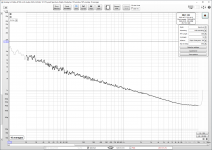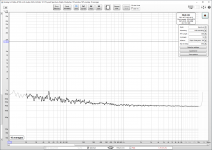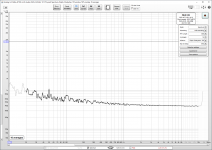See below the relative noise density measurement between TPS7A4700, configured to 4,2V dc out, and a 'reference 60ohm' input impedance.
measurement tool: Gerhard's pre, (cca 220pV/sqrtHz) >>RTX6001 >> HpWorks
the 60ohm ref line is, equivalent to 1nV/SqrtHz noise spectral density
As a consequence, the TPSA74700 output noise spectral density comes 20dB higher, 10nV/SqrtHz.
measurement tool: Gerhard's pre, (cca 220pV/sqrtHz) >>RTX6001 >> HpWorks
the 60ohm ref line is, equivalent to 1nV/SqrtHz noise spectral density
As a consequence, the TPSA74700 output noise spectral density comes 20dB higher, 10nV/SqrtHz.
Attachments
here there are all compared together: highest trace is TPS7A4700 (10nV/sqrtHz)
below LT3042, 4V dc out, 100mA load current, 10uF reference bypass cap (2nV/sqrtHz)
lowest trace is the 60ohm, 1nV/sqrtHz baseline reference
below LT3042, 4V dc out, 100mA load current, 10uF reference bypass cap (2nV/sqrtHz)
lowest trace is the 60ohm, 1nV/sqrtHz baseline reference
Attachments
Amazing thank you for sharing. This is what life should be, togheter we help each other and share our findings, to get the best products and to not be prey to marketing. Thank you. Edit : and to support the manufacturer of good products and fair prices 😉
Is it a good idea to use the pgfb (fast start resistor divider) to sink the 60mA ? Or should i use higher other values, and use a dedicated sink/load resistor ?
Is it a good idea to use the pgfb (fast start resistor divider) to sink the 60mA ? Or should i use higher other values, and use a dedicated sink/load resistor ?
Last edited:
given that You don't always know your load, I would leave it open, apply normal, relatively high value resistors, and place only at the particular application an independent load resistor.. (with adeguate power rating)..
Last edited:
What is a silentswitcher, is it better than using a center tap tranformer, into the lt3042 and 94 ?
Linear Audio Silent Switcher V3 – diyAudio Store
And there is more to it than just the used ICs ;-)
Jan
And there is more to it than just the used ICs ;-)
You are correct. It is also important to choose the right tool for the job. To illustrate here are 3 measurements of the self noise (i.e. input shorted) of my 60dB LNA. The LNA is my take on Samuel Groner's LNA using 4 unmatched 2sk369 fets scavenged from an old scrapped Pioneer A443 amp.
1. LNA powered with SilentSwitcher + battery pack
2. LNA powered with my LT30xx switcher + battery pack
3. LNA powered with my LT30xx switcher + USB from the same workstation 😱. Just look at those nasty spikes 😀
To be fair LNA is not the optimum usage of SilentSwitcher. It is excellent e.g. with Jan's Autoranger.
Attachments
I will definitely build an lna, just a question lna are low noise amplifiers, what prevent this kind of design to be used as amplifier for audio input ?
This is a 60dB LNA so it amplifies the input 1000x. Basically it could be used as MC head amp provided the RIAA correction is included. Some LNA designs are originally MM/MC head amps.
Hi I almost finished the design of my dual supply and i was wondering how far should i put the lt3042 from the bridge rectifier (radiation EMI and noise) ?
Thank you.
Thank you.
Hey guys by comparing both 3045 and 3042 datasheet it seems the 45 is better in relation to current output vs psrr ?
Also dropout is better in the 45.
Have you seen this ? is it of concern ?
Also dropout is better in the 45.
Have you seen this ? is it of concern ?
I would not worry about those differences. IME there is quite a lot of variation between LT30xx samples (or the surrounding components).
Depends on your application. LT3042 tops at 200mA but is cheaper and readily available. Also if you plan to build a negative supply as well LT3045+LT3094 makes a nice pair.
Thankyou again bohrok2610, I will go for the 45 ? it will avoid me a pcb redesign if i need more power one day. but to be fair i am looking for the cleanest lowest noise to my dual supply opamp.
Hello I have a 15v output on my lt3045. So I used 150k resisitor as Rset. and 22uF Cset.
Since I buy my resistors by 10 (to get them cheaper) I have spares of 150k res.
Now I need set up fast startup for the 22uF Cset at 15V output. but i want to use 150k res in the divider. what value could i use for the other resistor ?
I read the datasheet, it said howto set up fast startup, I have the formula, but what is the good ratio in %, to charge up Cset ?
I need help. Thank you.
EDIT . my Cset in 16V rated, is it enough?
Since I buy my resistors by 10 (to get them cheaper) I have spares of 150k res.
Now I need set up fast startup for the 22uF Cset at 15V output. but i want to use 150k res in the divider. what value could i use for the other resistor ?
I read the datasheet, it said howto set up fast startup, I have the formula, but what is the good ratio in %, to charge up Cset ?
I need help. Thank you.
EDIT . my Cset in 16V rated, is it enough?
Last edited:
Can some one explain me how the fast startup work ?the voltage divider of external resistors, RPG2 and RPG1 program the power good threshold and also activates the fast start-up circuit. Output voltages below 300 mV disable the programmable power good and fast start-up capabilities.
Does it mean that when the PGFB pin hits 0.3V it will disable disable the 'fast charging' ?
I set the 3042 at 15v. so i have spare of cset 150k resistor i want to use to set Fast startup.
If I use 150k + 50k divider it means I am dumping a 75% of the output voltage (since the voltage divider is connected to Vout pin), so it will hit 0.3v at the PGFB pin (and stop fast charging) when the Vout pin is at 1.2V. Or does it mean I have set up fast charging at 75% ?
0.3v is 2% of 15v. if i want to set the PGFB pin to be at 0.3V when I hit 15Vout, I need 150k+3K voltage divider ?
Can you help me because I read the datasheet many times this full week and I can't understand.
If it's a ceramic X5R or X7R SMD capacitor, chances are it has only 10 to 20 % of its capacitance left at 15/16 of its nominal working voltage.EDIT . my Cset in 16V rated, is it enough?
- Home
- Amplifiers
- Power Supplies
- Yet another ultra low noise high PSRR LDO - LT3042




